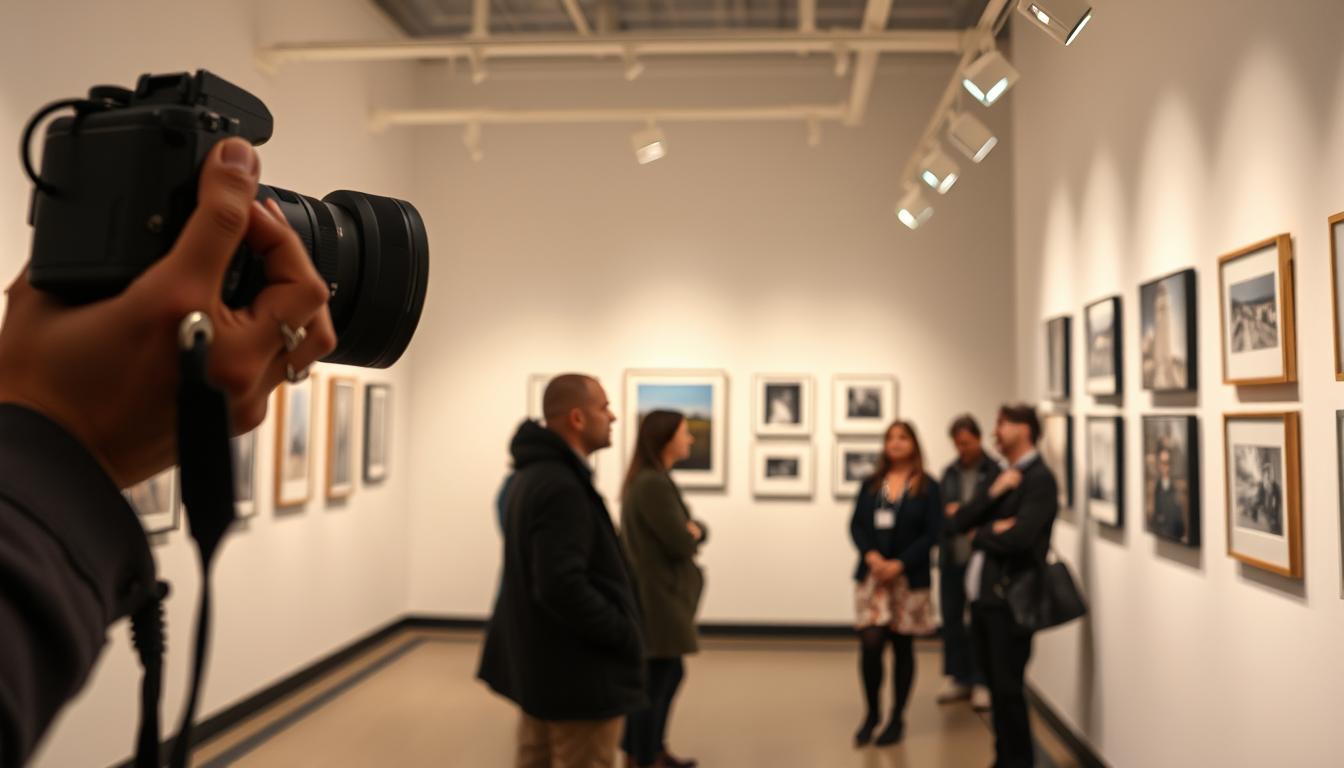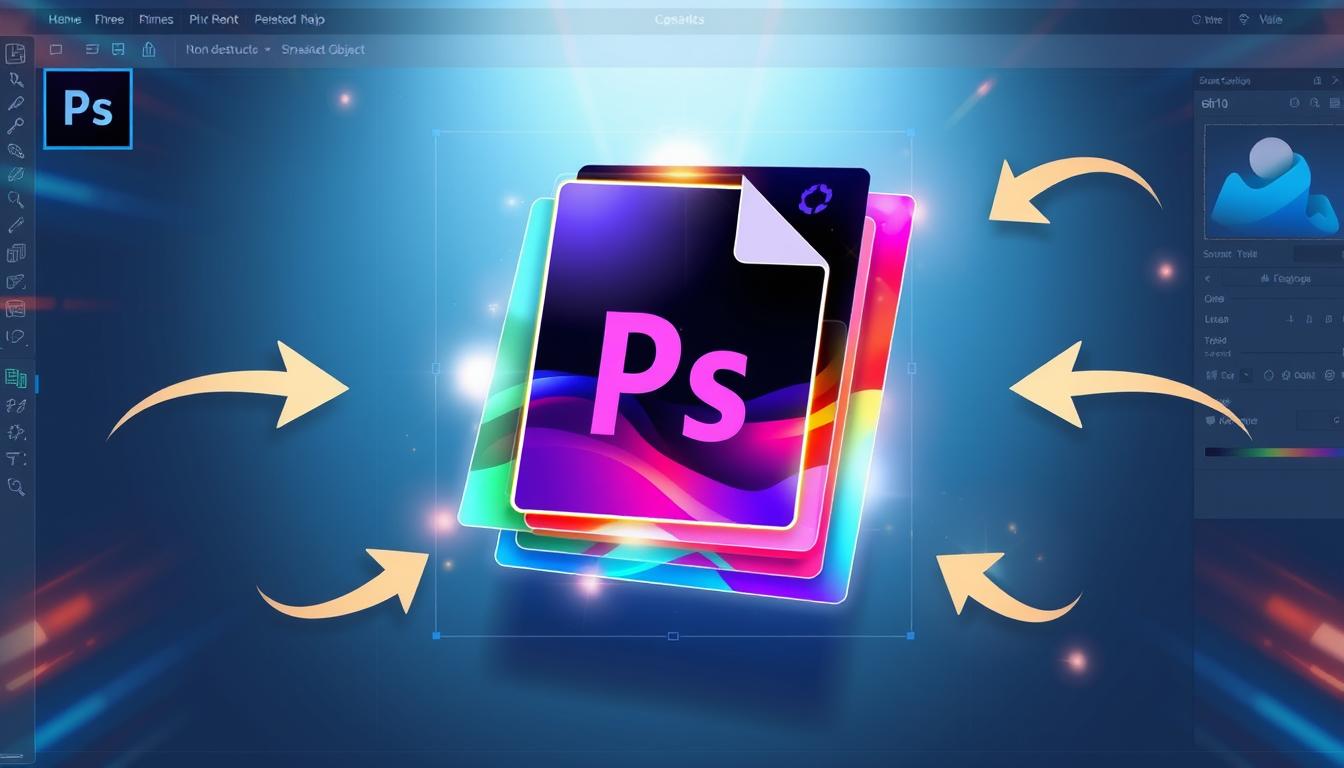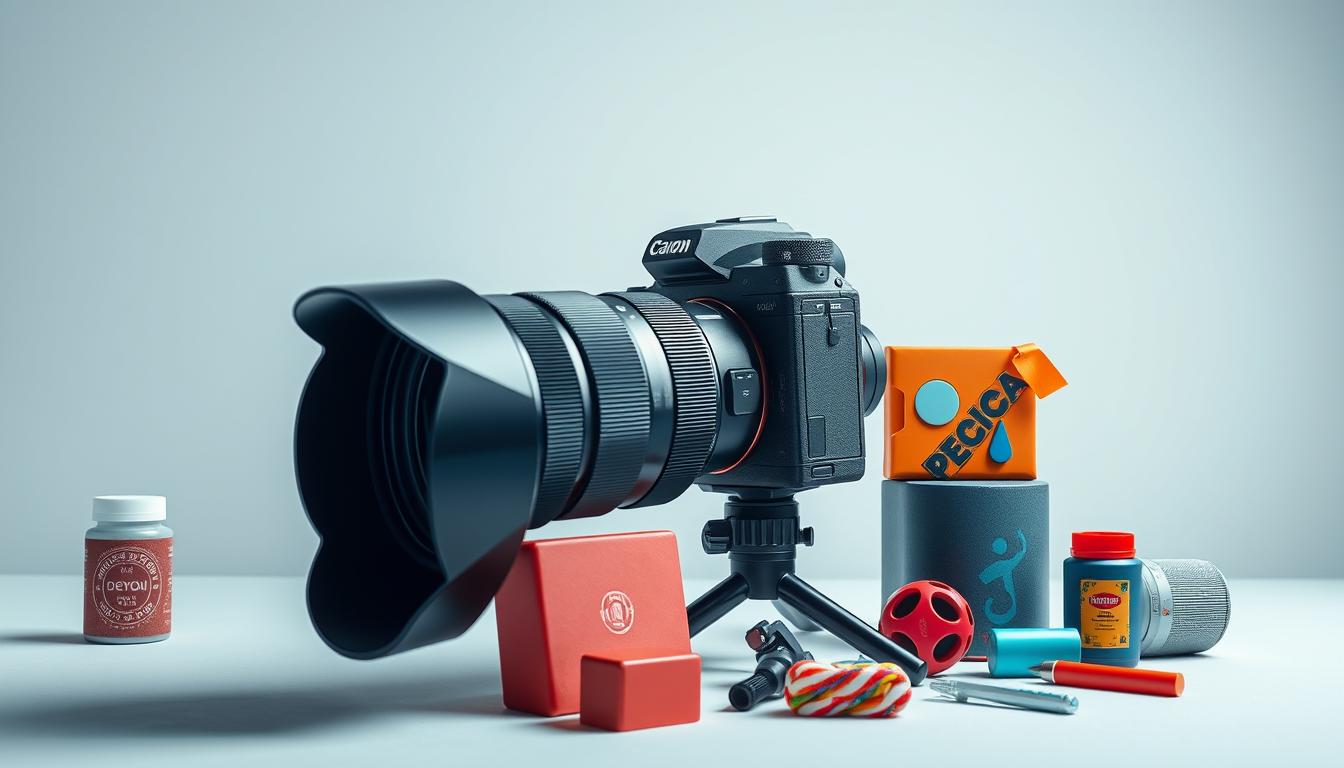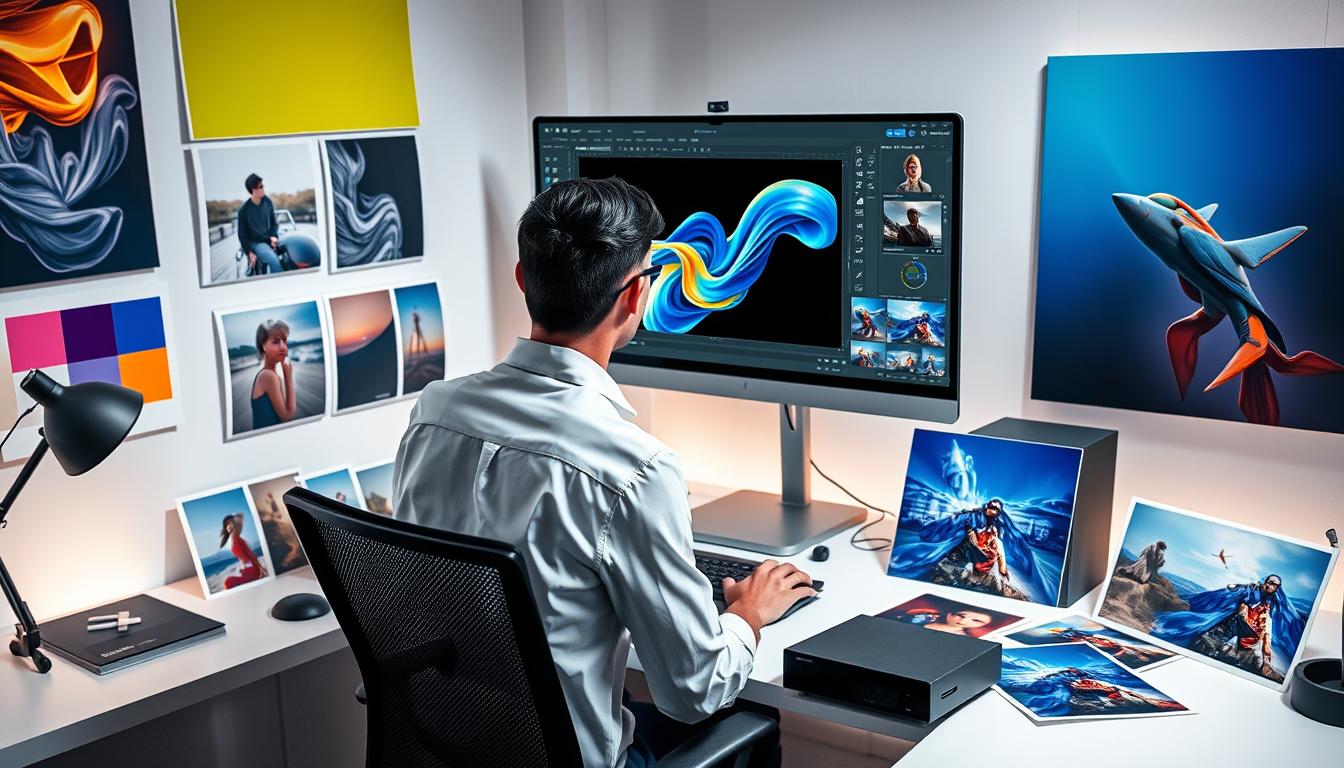Capturing the true feel of an art exhibition takes both skill and creativity. It’s about using the right techniques while also having the eye to bring the artwork and atmosphere to life in every shot. Exhibition photography is a special field. It involves taking photos of artworks, installations, and events in a way that honors the original pieces.
A good photography guide can teach you the skills needed to shine in this field. You’ll learn about lighting, composition, and how to work with artists and curators. It’s all about capturing the beauty of art through photography in a way that truly does it justice.
Defining Exhibition Photography
Exhibition photography is a special field that needs both technical skills and creative vision. It’s about taking pictures that look great and also share a message or touch our hearts.
Art of Creating Gallery-Worthy Images
Creating images for galleries takes both skill and creativity. Photographers need to pay attention to lighting, composition, and focus to make each shot stand out and bring the artwork to life.
How Exhibition Photography Differs from Other Genres
Exhibition photography is different from other types like portrait or landscape. It focuses on capturing the heart of an exhibition or event. It needs understanding the setting and showing the mood and details of the show.
By getting good at exhibition photography, photographers can make pictures that are not just beautiful but also tell a story. This makes it a special and engaging field in photography.
What Is an Exhibition Photography: Core Concepts
Understanding exhibition photography is key for photographers. It’s not just about taking pictures. It’s about sharing a message, telling a story, or stirring emotions with a chosen set of photos.
Exhibition photography is all about capturing the purpose behind the artwork. Great photographers don’t just take pictures—they think about what the photos should say. Whether it’s showcasing new pieces, telling a story, or sparking emotion, every shot should have meaning. This thoughtful approach not only makes the images more powerful but also helps attract the right audience online.
Purpose and Intent Behind Exhibition Work
The goals of exhibition work vary. They can include:
- Showcasing artistic skill and technique
- Telling a story or conveying a message
- Evolving an emotional response or sparking dialogue
- Documenting an event, place, or culture
Knowing their intent helps photographers present their work in a way that clearly shares their vision.
Relationship Between Photographer, Artwork, and Viewer
The photographer, the artwork, and the viewer all come together to create something special. Without that connection, the images wouldn’t truly come to life. It’s this relationship that makes the experience powerful and memorable for everyone involved.
The photographer tries to share a message or feeling through the photo, but how the viewer sees it matters just as much. That mix is what gives the exhibition its true meaning and impact.
A great exhibition balances the photographer’s vision with the viewer’s experience. This creates a conversation between the artwork and its audience. This connection is at the heart of exhibition photography, showing how art interacts with its viewers.
Themed Collections and Series
Themed exhibitions focus on a specific subject or style. They let photographers dive deep into a theme, creating a journey for the viewer. As
These exhibitions are engaging because they make viewers think about different views.
In summary, photography exhibitions come in many forms. They offer photographers a chance to share their work, connect with viewers, and add to the artistic conversation.
Essential Equipment for Exhibition Photography
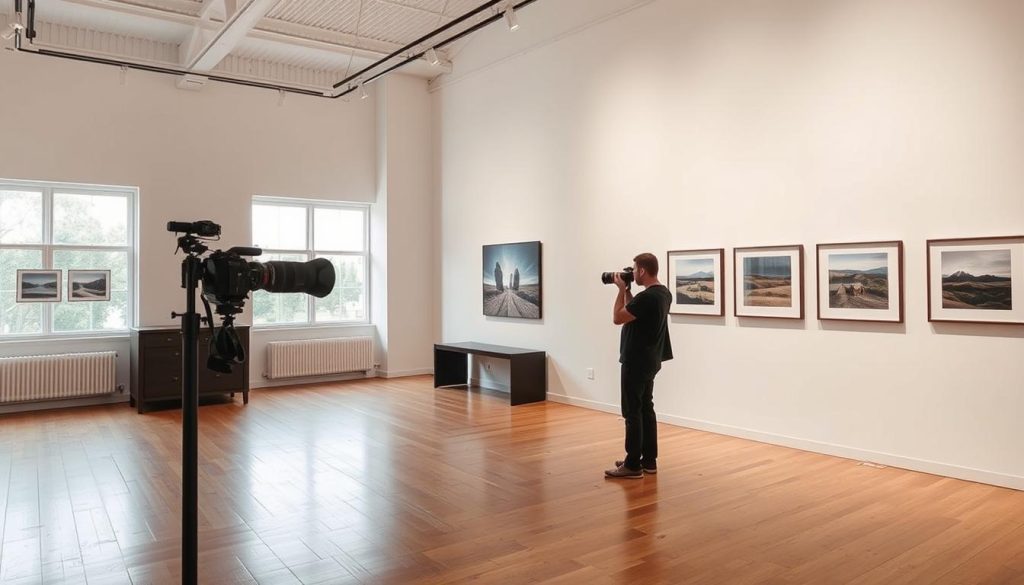
Having the right equipment is essential for capturing stunning exhibition photography. It allows photographers to showcase their best work with clarity and precision. To achieve high-quality images, certain key tools are a must.
Camera and Lens Considerations
The camera and lens are vital for exhibition photography. A high-resolution DSLR or mirrorless camera is best for detailed shots. Lenses with a wide aperture (like f/1.4 or f/2.8) help focus on the artwork, making the background less noticeable.
- Prime lenses for sharpness and clarity
- Zoom lenses for versatility and convenience
- Lenses with image stabilization for reducing camera shake
Lighting Equipment
Lighting is also crucial for exhibition photography. Soft, diffused lighting reduces glare on artworks, even those behind glass. You might want to use:
- External flash units for extra light
- Continuous lighting for a natural look
- Diffusers and softboxes to soften the light
Technical Skills for Exhibition-Quality Images
To make images fit for exhibitions, photographers need to learn several key skills. These skills improve image quality and meet exhibition standards.
Mastering Exposure and Focus
Getting the right exposure and focus is crucial for top-notch images. It’s about knowing how to adjust camera settings for light and ensuring the subject is clear.
Considerations include:
- Understanding aperture, shutter speed, and ISO
- Using autofocus modes effectively
- Employing techniques like focus stacking for complex compositions
Understanding Resolution and Print Quality
For exhibitions, image resolution and print quality are key. Photographers must know how to capture images at the right resolution and prepare them for printing.
Color Management and Calibration
Color accuracy is essential for exhibition photography. It ensures images match the artist’s vision. This means calibrating camera, monitor, and printer for color consistency.
Composition and Artistic Elements
In exhibition photography, composition and artistic elements are key. They turn a good photo into a great one, making it truly stand out.
The photographer’s shot composition greatly affects the image’s look and feel.
Creating a consistent visual style is vital. It makes your work look good and stay true to its theme. It’s important to consider the color palette, lighting, and composition to connect with your audience and convey the right message.
Developing a Cohesive Visual Style
To have a cohesive style, decide on the look you want to share. Use the same colors, try out lighting, and stick to a composition style. This makes your exhibition flow well and grab the viewer’s attention.
Creating Narrative Through Images
Exhibition photography is about telling a story with photos. Creating a narrative is about connecting each photo to the next, building a story that flows naturally. This builds a story that grows as the viewer explores the exhibition.
Balancing Technical Perfection with Artistic Expression
Technical skill is crucial for quality images. But, don’t forget about artistic expression. Exhibition photography is about feeling and idea as much as it is about skill. Finding this balance makes your images connect with viewers on a deeper level.
Lighting Techniques for Gallery-Worthy Photos

In exhibition photography, lighting is more than just turning on a light. It’s an art form that shifts the way we experience and perceive the artwork. To get gallery-worthy photos, mastering different lighting techniques is key.
Natural vs. Artificial Light
Choosing between natural and artificial light depends on the space and the artwork. Each has its strengths, so it’s about finding what works best for the vibe you want to create. Natural light gives a genuine, lively vibe but can be tricky to manage. Artificial light offers more control and flexibility, allowing you to adjust it to perfectly suit the artwork.
Creating Mood and Atmosphere
Lighting greatly affects the mood and atmosphere of your photos. Soft, diffused light can make scenes calm, while bold, directional light adds drama. Trying out different lighting setups can help you capture the right emotional feel in your photos.
Lighting Setups for Different Exhibition Styles
Each exhibition has its own lighting needs. For example, modern art might need sleek, simple lighting, while historical artifacts might look better with warm, traditional lighting. Consider these points:
Post-Processing for Exhibition Photography
Exhibition photography is more than just snapping pictures; it’s about capturing the essence of the art and creating an experience for the viewer. It involves a detailed post-processing stage where images are refined for display. This stage is key to turning good photos into eye-catching visuals that draw in gallery visitors.
Editing Workflows for Consistency
Having a consistent editing workflow is essential for a unified look in your exhibition. To ensure consistency, you should establish a set of steps to edit all your photos in the same way, giving them a cohesive look and feel.
Consistency is key to making your exhibition look professional and impactful.
Many photographers use Adobe Lightroom or Capture One for this. These tools help apply presets and edit multiple images at once. This makes editing faster and ensures all images look the same.
Preparing Files for Large Format Printing
When getting your images ready for large prints, think about the file’s resolution and color profile. High-resolution images are necessary for clear, detailed prints. For most exhibition prints, a resolution of 300 DPI is recommended.
Maintaining Image Integrity Through Processing
Editing is important, but keeping the original image’s integrity is just as crucial. Over-editing can make images look unnatural and lose their original meaning. Subtlety is often the best approach, enhancing the image without changing its core.
By focusing on these post-processing aspects, photographers can make sure their images are not only beautiful but also true to their original vision.
Preparing Your Work for Display
Getting your work ready for an exhibition is key. It’s as important as taking the photos. Good preparation makes your photos more interesting and impactful.
Think about the printing options for your work. The printing method can change how your photos look.
Printing Options and Considerations
There are many ways to print your photos, each with its own benefits.
Framing and Presentation Choices
Framing is crucial for presenting your work. The right frame can make your photo look even better. Consider the frame’s material, color, and style to complement your photo and enhance its overall presentation.
Creating Artist Statements and Titles
An artist statement gives context to your work. It shows your creative vision. Titles add meaning to each piece. Make these elements thoughtful to enhance the viewer’s experience.
By focusing on these details, you can showcase your work in the best way. This will engage your audience and make a lasting impression.
Learning from Master Exhibition Photographers
Studying the techniques of master exhibition photographers can teach us a lot. They have spent years perfecting their craft. This hard work shows in their work.
Case Studies of Successful Exhibitions
Looking at case studies of hit exhibitions, we see some common traits. This involves having a keen eye for detail and a deep understanding of the subjects being captured.
Analyzing Techniques and Approaches
The techniques used by top photographers are creative and varied. There are two main areas to focus on:
Composition Strategies
Strong composition is essential for making images stand out. Key strategies include using leading lines, symmetry, and thoughtful framing to guide the viewer’s eye and create balance.
Subject Matter Selection
Choosing the right subject matter is also vital. Top photographers pick themes that speak to their audience.
Breaking Into the Exhibition World
Photographers wanting to show their work in exhibitions need a solid plan. Photographers must build a portfolio that resonates with curators and gallery owners, showcasing their unique style and vision. This requires talent, technical skill, and smart planning.
Networking with Curators and Gallery Owners
Networking is vital for getting into exhibitions. Go to photography events, join groups, and connect with curators and gallery owners online. Building relationships in the industry can open doors to shows and collaborations. As
Funding Your Exhibition Through Grants and Sponsorships
Finding money for exhibitions can be tough. Look for grants for photographic arts and seek sponsorships from brands that match your vision. Prepare a compelling proposal that explains your project’s goals, budget, and impact.
By focusing on these areas, photographers can boost their chances of showing their work in exhibitions. This way, they can share their art with more people.
Conclusion
Exhibition photography combines technical skill with artistic vision. It captures the essence of artworks and exhibitions for galleries, artists, and fans. We’ve covered the basics, essential tools, and skills needed to make gallery-quality images.
Learning to compose, light, and edit your photos is key. This way, you can make images that pull viewers into the art world. You also need to prepare your work for display, including printing, framing, and creating artist statements and titles.
In summary, starting your exhibition photography journey is both tough and rewarding. By following the guide, you’ll be able to create images that engage audiences. This marks the end of your photography guide journey, with a successful exhibition photography conclusion.
FAQ
What is exhibition photography?
Exhibition photography is about taking pictures of art, installations, or exhibits in galleries or museums. It’s for documenting, promoting, or expressing art.
What equipment do I need for exhibition photography?
You’ll need a camera, lenses, a tripod, and lighting like strobes or continuous lights. This gear helps capture top-notch images in different lighting setups.
How do I prepare my images for exhibition?
First, edit your photos to make sure they look good and are consistent. Then, get your files ready for large prints.
What are the different types of photography exhibitions?
There are solo shows, group exhibits, themed collections, and collaborative ones. Each offers unique chances to showcase your photography.
How do I get my work noticed by galleries and curators?
Build a strong portfolio and network with industry folks. Also, look into grants or sponsorships to support your shows.
What is the role of lighting in exhibition photography?
Lighting is key in exhibition photography. It sets the mood and quality of your images. You can use natural and artificial light to achieve this.
How do I choose the right printing options for my exhibition?
Think about print size, material, and finish. Also, consider the look and message you want to share with your work.
What is the importance of artist statements and titles in exhibition photography?
Artist statements and titles add context and meaning to your work. They help viewers understand and appreciate your photography, making your exhibit successful.

